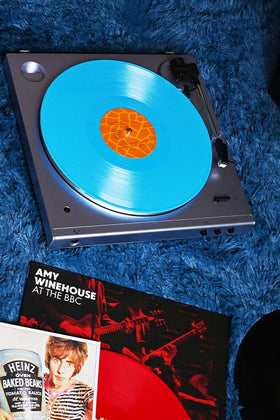Stereo vs. Mono in Sound: What's the Difference?
If you’re an audio enthusiast at any level, you’ve probably heard people extol the virtues of either stereo or mono sound. Most vinyl hobbyists have a strong preference for one over the other because of the perceived differences in sound quality.
But what do stereo and mono mean when we’re talking about audio? What’s the difference between their sounds? This blog post will give you some information so you can join the debate yourself.
What’s an Audio Channel?
Before we dive into an explanation of the differences between stereo and mono, a key concept must be understood. That concept is the audio channel.
Audio channels aren’t complicated concepts. A channel is simply one source of the sound. A speaker is a channel. A microphone is a channel. Two speakers are two audio channels. In the simplest terms, each single-point source of sound is a channel.
When audio is recorded, it can be recorded on multiple channels or in just one. This is where terms like mono and stereo come in.
What Does Mono Mean in Sound?
Mono is Greek for one, and when we’re talking about audio, mono means one sound source. If you have an audio setup that only includes one speaker, you probably have mono sound. More precisely, when mono audio is recorded, all of the channels that make up the recording are recorded on one channel.
To understand what this means, think of listening to music on headphones. If you take one headphone out of your ear, what happens? If the music continues playing and sounds the same, you’re listening to mono audio.
In the example above, everything is on one track, and when you listen on headphones, both ears hear the same thing. This is simple and convenient, but it also means that the music is much less layered and complex than a stereo recording. For this reason, mono is mostly found on older recordings, amateur demos, and low bandwidth radio shows these days.
What Does Stereo Mean?
Stereo is recorded on two different channels. To use the previous example again, when you’re listening to a recording in stereo and take a headphone out of your ear, you won’t hear the complete track because each ear — each channel — is playing two completely different tracks.
Stereo tracks have a deep, complex sound that immerses the listener more fully into the music. Usually, the bass is in one channel and treble in the other, although inventive producers play with this convention a lot. Because of its broader, deeper sound, stereo has become the standard for professional sound recordings.
Stereo is the modern standard for professional audio recordings and has spawned dozens of media recording applications. Films, streaming audio, television, and even some live playback are all in stereo.
What’s the Difference Between Stereo and Mono?
When you’re buying records, you’ll find them in both stereo and mono, so it’s important to know the differences.
Stereo vs. Mono: Sound
Stereo sounds more complicated than mono because it’s recorded on several channels. That recording is then reproduced and played back on two separate outputs (speakers, headphones, etc.) This separation creates a more complex sound that is more immersive and more pleasing to audiophiles.
Mono, on the other hand, is both recorded and reproduced on one track. This means it sounds relatively simple and flat compared to stereo. It’s simpler to record mono audio, but it’s also a much less varied sound.
There’s another way to think about the differences between stereo and mono sound quality for easy understanding. Stereo recordings simply have more sound available for playback. More is recorded, and more is reproduced on the tracks that you listen to.
Stereo vs. Mono: Modernity
One of the reasons that mono audio is so simple is because it’s the older of the two forms of sound recording and playback. For this reason, you’ll often find older recordings, including vinyl, that have mono playback. Amateur recordings also use mono a lot, simply because the recording process is much simpler for a new producer.
Stereo, on the other hand, is a newer technology and is much more complicated to record and produce. It isn’t the newest form of vinyl playback technology, however, when you buy new vinyl, it will be in stereo playback format.
Even though quadraphonic and other multi-track sound recording systems exist, stereo is still the gold standard for audio recordings and has been since roughly 1940. Mono has all but disappeared in audio recording, although two pieces of modern technology still use it: phones and radio stations.
Stereo vs. Mono: Complexity
Let’s go back to our headphones example, only this time, instead of headphones, think of big beautiful freestanding speakers. If we play a mono track, the same thing is going to play from each speaker, no matter how many we have. If we have one speaker, we’ll hear everything that was recorded on the track. If we have 15 speakers, they’ll all play the same thing.
In contrast, if we play a stereo track through our speakers, the situation is a bit different. If we set up our speakers correctly, some will be on the left channel and some on the right. If we have two speakers, there will be one on each channel, and each will play a different track that makes up the whole song when played together.
If we have 15 speakers, the ones assigned to the left channel will all play the same thing and the ones assigned to the right will all play the same thing. However, if we only have one speaker and a studio track, you’ll only hear half of the sounds in your recording. Stereo audio needs multiple channels to play back correctly.
This makes stereo much better sounding but also more complicated to set up and balance correctly. A lot of vinyl enthusiasts love stereo records in particular because the combination of the more complex stereo sound and the richness and warmth of a record is very pleasant for audiophiles.
What Does Stereo vs. Mono Mean for My Vinyl Collection?
Generally, vinyl records with mono playback are a rarity. They’re often quite old and are therefore collector's items. Mono records haven’t been made for many years, and while if you find them, they are playable, but the sound quality is not very impressive.
Stereo vinyl is much easier to find and sounds better. The playback may be a bit more complicated to set up, but the depth and richness of the sound are very worth the extra steps.
If you’re looking for some vinyl to play in stereo, check out Sound of Vinyl.
Sources
The How-To Geek Guide to Audio Editing: The Basics | How To Geek
A Guide to Monaural, Stereo, Multichannel, and Surround Sound | Lifewire




